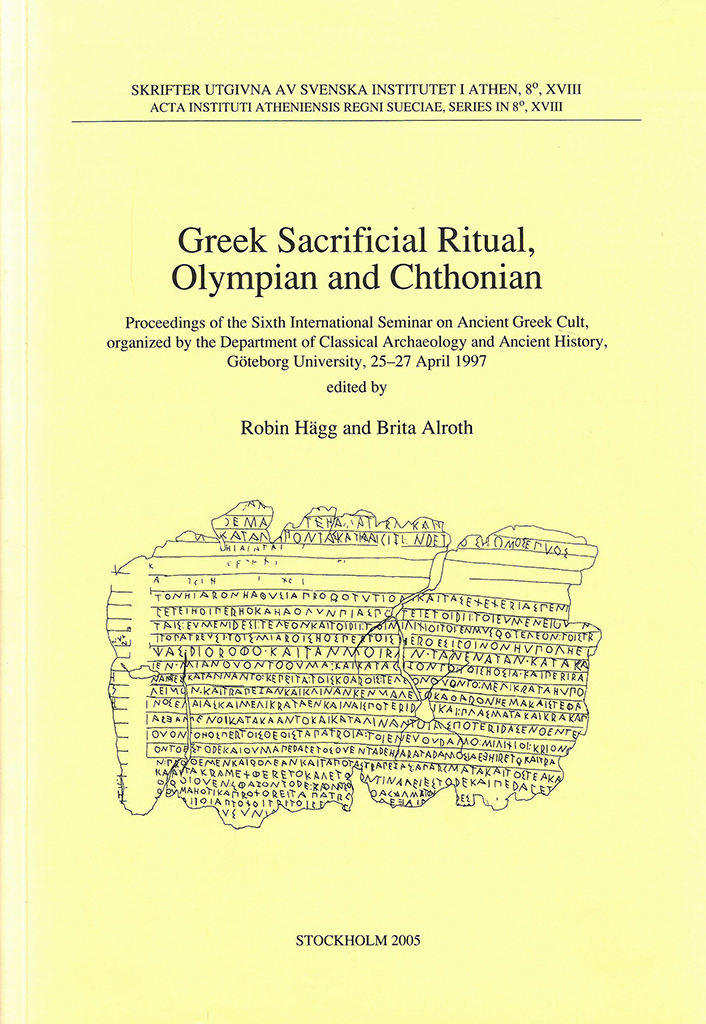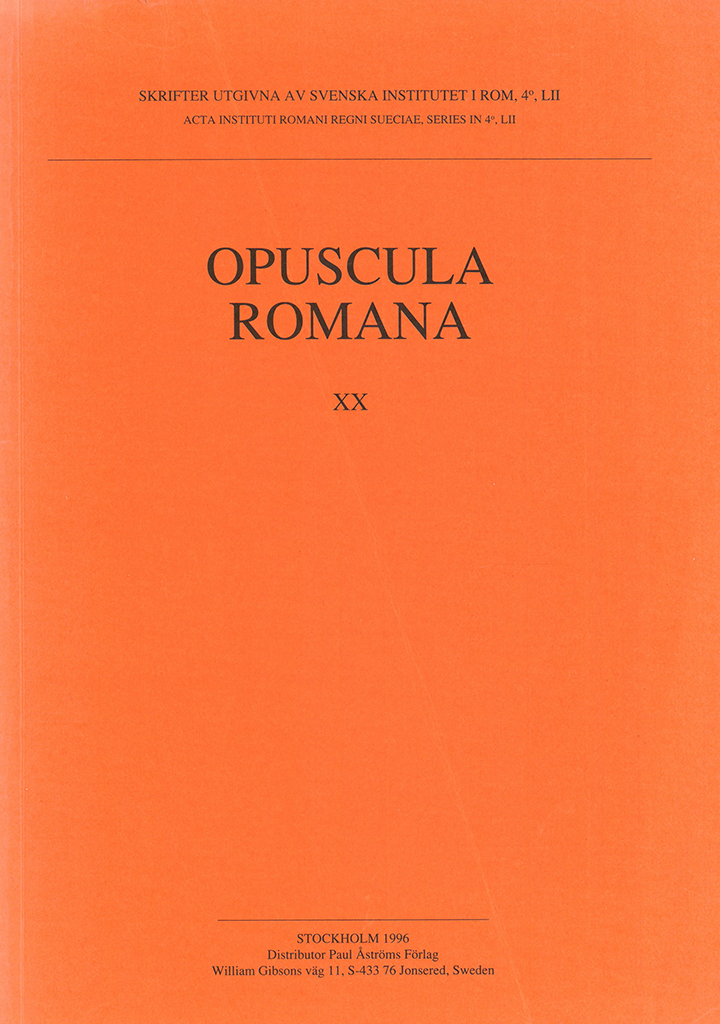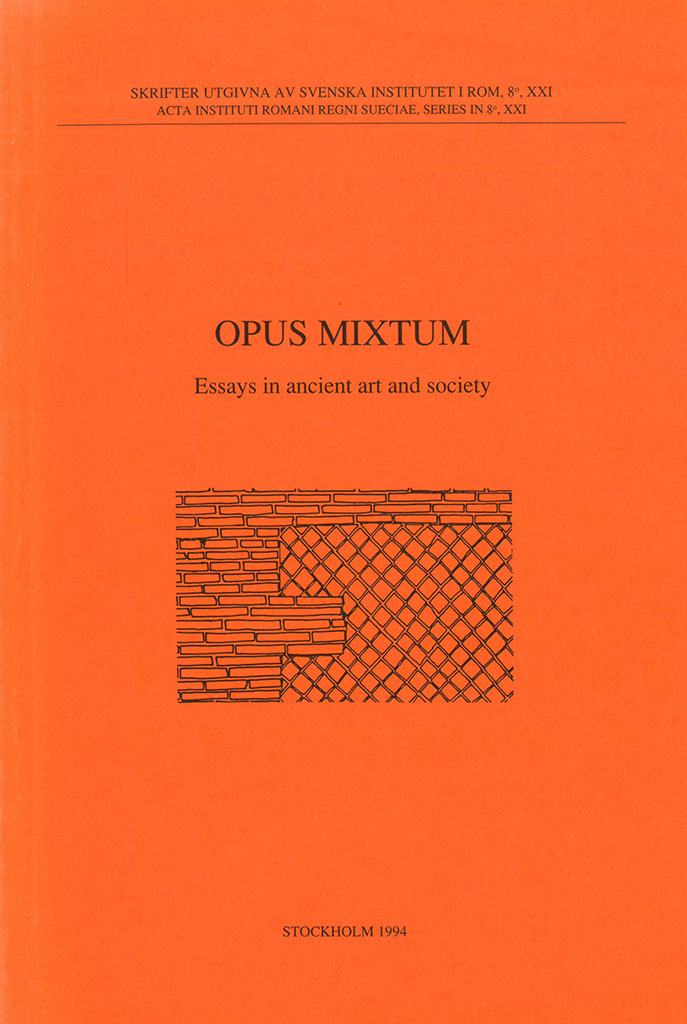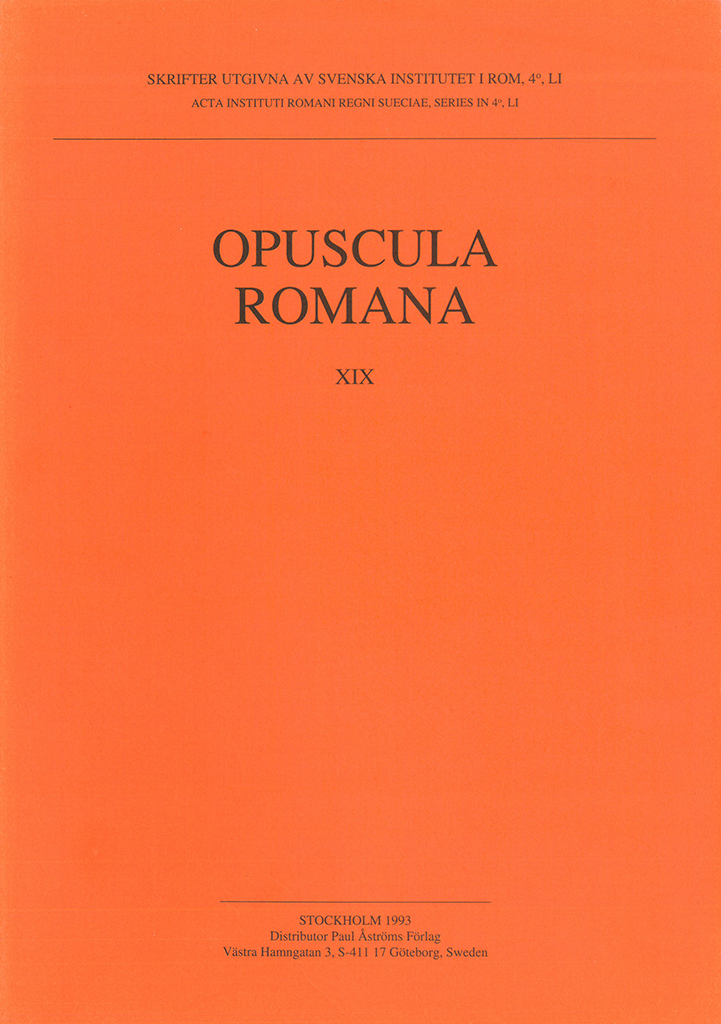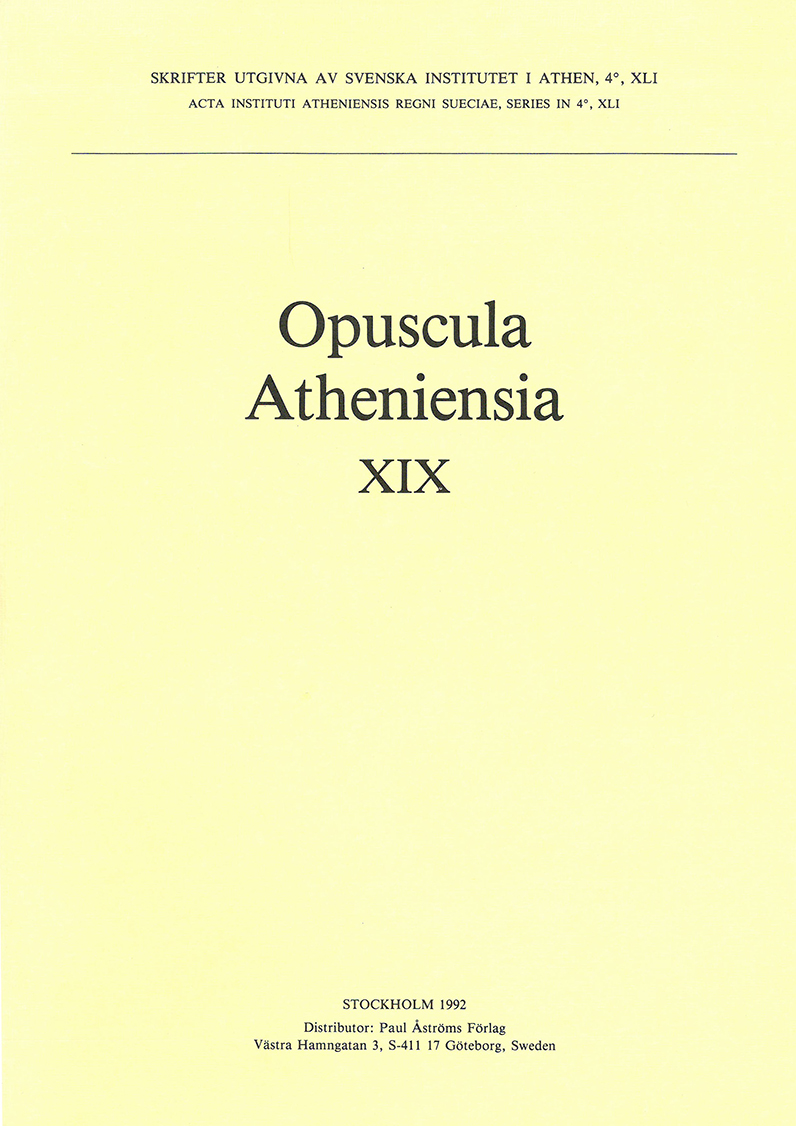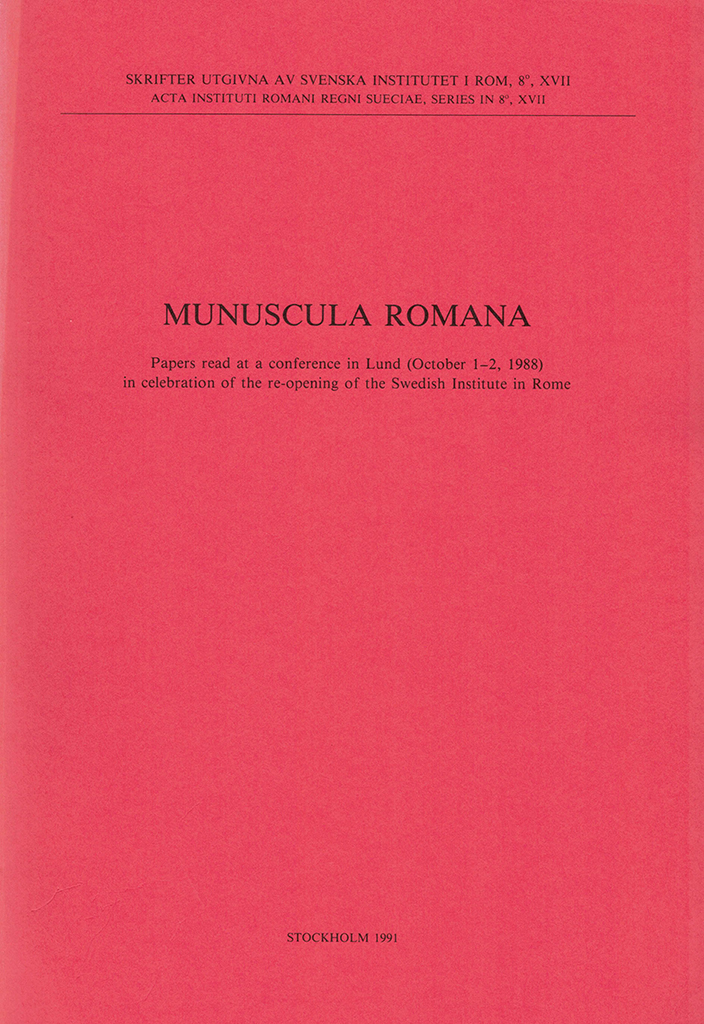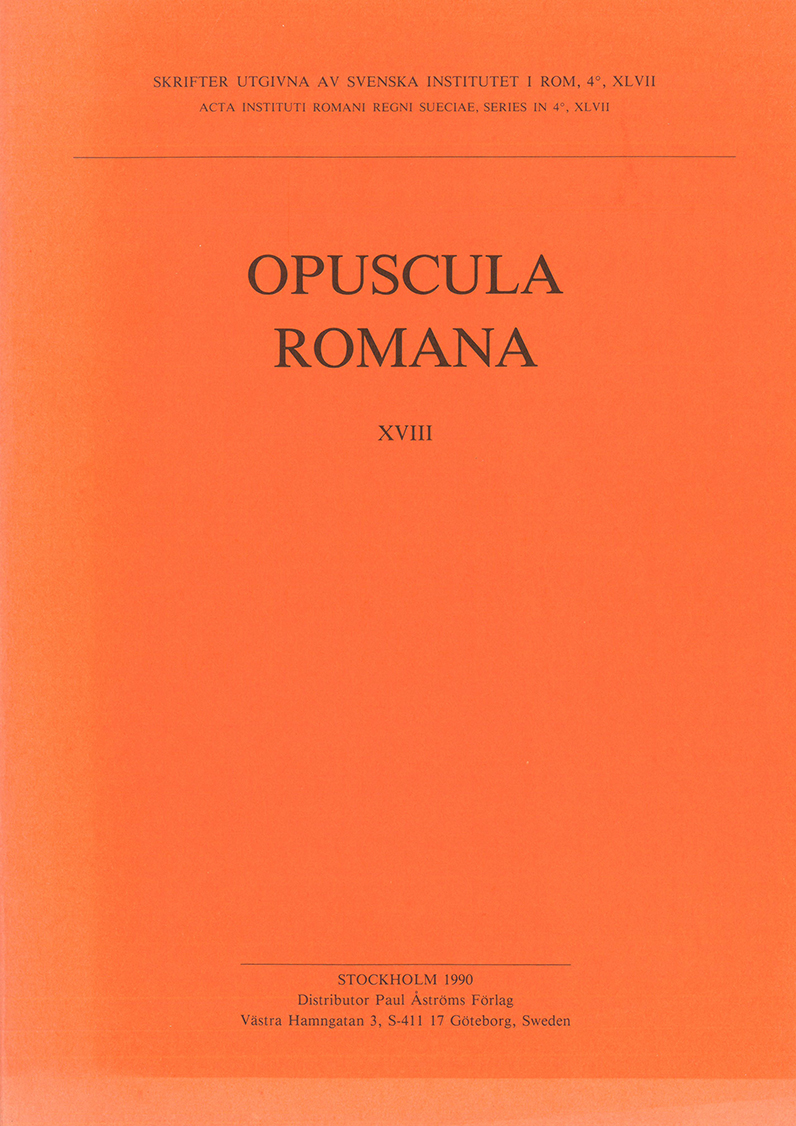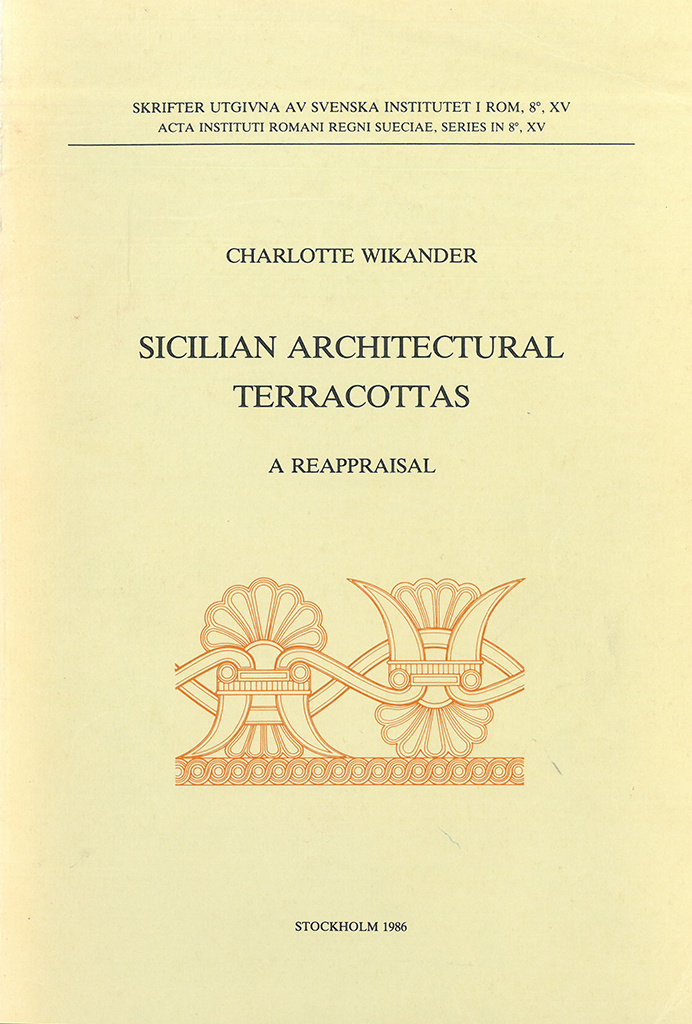Distributed by Astrom Editions. Greek sacrificial ritual, Olympian and Chthonian. Proceedings of the Sixth International Seminar on Ancient Greek Cult, organized by the Department of Classical Archaeology and Ancient History, Göteborg University, 25–27 April 1997 Edited by Robin Hägg & Brita Alroth A collection of eighteen papers, read or circulated at an international seminar in Göteborg, that deal with the ancient Greek sacrificial ritual, with special reference to the traditional dichotomy between the Olympian and the chthonian aspect, the relevance of which has been questioned in modern research. Among the special topics discussed are sacrifices to heroes and in the cult of the dead, magical sacrifice, sacrifice to the sea, pig sacrifice and the sacrifice of pregnant animals. Other aspects dealt with include the role of dedications in the cult and the practicalities of ruler-cult, as well as the priest’s role in Greek sacrifice. Several contributions discuss the implications of the recently published lex sacra from Selinous for the understanding of Greek sacrificial practice, reinterpreting previously known inscriptions in the light of the new evidence. Two papers deal with descriptions of sacrifice in Greek tragedy (Aeschylus, Oresteia; Sophocles, Trachiniae). There is a bibliographical survey of faunal remains from Greek sanctuaries…
Published by the Swedish Institute of Classical Studies in Rome. Distributed by Astrom Editions. Opuscula Romana 20. Pär Göran Gierow dedicata Contents Kristina Berggren, Tre tombe a cremazione con trace di legno nella necropolis di Quattro Fontanili a Veio (Roma) Ingrid E.M. Edlund-Berry, The power of cults and sacred spaces. The interpretation romana of sanctuaries in southern Italy and Sicily Maria C. Eriksson, Two Etruscan mirrors in the Thorwaldsen Museum, Copenhagen Björn Forsén & Timo Sironen, Bolli laterizi romani nell’Antikmuseet in Göteborg Lena Landgren, The Roman pleasure garden—foundations for future studies Peter Liljenstolpe, De ornamentis templi Urbis. Reconstructing the main order of the temple of Venus and Roma in Rome Alessandro Naso, Osservazioni sull’origine dei tumuli monumentali nell’Italia centrale David Ridgway, Greek letters at Osteria dell’Osa Paavo Roos, Strabo and the water-mill at Cabeira. Some considerations Raffaele Santillo, Il «saxum ingentem» a Ravenna a copertura del Mausoleo di Teoderico: problemi e soluzioni Martin Söderlind, A central Italic, terracotta votive head in the Classical Museum of Antiquities in Lund (in association with Pierluigi Bianchetti, technical analysis) Margareta Strandberg Olofsson, Pottery from the monumental area at Acquarossa: a preliminary report Bengt E. Thomasson, Laterculi praesidium. Addendorum series altera Örjan Wikander, Senators and…
Distributed by Astrom Editions. Opus Mixtum. Essays in ancient art and society Edited by Eva Rystedt, Charlotte Scheffer, and Charlotte Wikander Fifteen papers on various aspects of ancient art and society are gathered in this volume. They deal with the choice of moment depicted in the Parthenon frieze, the use of the Greek architectural orders in political propaganda, and the “programme” of the relief plaques from zone F at Acquarossa which is suggested to be celebrations connected to the ruler. The architectural layout of a well-temple in Sardinia is interpreted as an iconographic message of the cult of Tanit-Astarte. The significance of the horse in connection with death and the various types of female deities connected with horses in Archaic Greek religion are discussed, as well as the image of Artemis Ephesia and its connection with the mysteries of the goddess, the epithet Ambologera (“Delayer of old age”) attributed to Aphrodite, and the role of women in Roman religion. A white-ground lekythos by the Achilles Painter with the “mistress-and-maid” motif associated with music-making is analysed. A reconstruction of the Laocoon group, especially regarding the positions of the serpents is put forward. A marble head of Dionysos in the Swedish Zorn…
Published by the Swedish Institute of Classical Studies in Rome. Distributed by Astrom Editions. Opuscula Romana 19 Contents Carl Nylander, Gustavo VI Adolfo, il “re archeologo” S.M. Il Re Gustavo VI Adolfo, Discorso in occasione del conferimento della laurea ad honorem Oxford 1955 Olle Brandt, Recent research on the tomb of Eurysaces Peter Danner, Stützen im Giebel—Ein Motiv der etruskischen Wandmalerei Harry Erkell, L’Imperatore Commodo ed Ercole-Melcart Pamela Hemphill, The Romans and the San Giovenale area Bo Lawergren, Lyres in the West (Italy, Greece) and East (Egypt, the Near East), ca. 2000 to 400 B.C. Örjan Wikander, Senators and equites V. Ancestral pride and genealogical studies in Late Republican Rome Charlotte Wikander, Acquarossa: campagna di scavo 1991 The Swedish Institute in Rome. Report for the academic years 1990–91 and 1991–92 Book reviews Charlotte Wikander, review of R.R. Knoop, Antefixa Satricana. Sixth-century architectural terracottas from the sanctuary of Mater Matuta at Satricum (Le Ferriere) Örjan Wikander, review of O. Salomies, Die römischen Vornamen. Studien zur römischen Namengebung Örjan Wikander, review of I. Nielsen, Thermae et balnea. The architecture and cultural history of Roman public baths Örjan Wikander, review of G. Brodribb, Roman brick and tile Göran Bäärnhielm, review of B. Mattson,…
Published by the Swedish Institute of Classical Studies in Rome. Distributed by Astrom Editions. Deliciae fictiles. Proceedings of the First International Conference on Central Italic Architectural Terracottas at the Swedish Institute in Rome, 10–12 December 1990 Edited by Eva Rystedt, Charlotte Wikander & Örjan Wikander Thirty-three papers on architectural terracottas read at an international conference in Rome. The papers include contributions on Greek material, but the main emphasis is placed on Central Italic roofs (from Northern Etruria to Campania) from the Archaic period. Several papers present hitherto unpublished material, either recently excavated or from earlier, unpublished, excavations and collections. Contents Eva Rystedt, ‘Preface’, p. 7 Arvid Andrén, ‘L’avviamento’, p. 9 ‘General list of abbreviations’, pp. 11–16 Nancy A. Winter, ‘The Greek background for Archaic architectural terracottas of Central Italy’, pp. 17–20 John F. Kenfield, ‘A modelled terracotta frieze from Archaic Morgantina: its East Greek and Central Italian affinities’, pp. 21–28 Concetta Ciurcina, ‘Rapporti tra le terrecotte architettoniche della Sicilia orientale e quelle dell’Italia centrale’, pp. 29–38 Elena Epifanio Vanni, ‘Antefisse di tipo campano a Himera’, pp. 39–43 Maria Bonghi Jovino, ‘La decorazione architettonica di Capua: peculiarità, itinerarii e modelli’, pp. 45–54 Ninina Cuomo di Caprio & Matilde Romito, ‘Fratti di…
Published by the Swedish Institute at Athens. Distributed by Astrom Editions. Opuscula Atheniensia 19 Contents Carl Nylander, ‘Sture Brunnsåker, 1925–1978’ (p. 9) Paul Åström, Katie Demakopoulou, Nicoletta Divari-Valakou & Peter M. Fischer, ‘Excavations in Midea, 1989–1990’ (pp. 11–22) Gisela Walberg, ‘Excavations on the Lower Terraces at Midea’ (pp. 23–39) Birgitta Bergquist, ‘A particular, Western Greek cult practice? The significance of stele-crowned, sacrificial deposits’ (pp. 41–47) Mary Blomberg, ‘The meaning of Χελιδών in Hesiod’ (pp. 49–57) Robin Hägg & Gullög C. Nordquist, ‘Excavations in the Levendis sector at Asine, 1989. A preliminary report with an appendix on the animal bones by Katrin Moberg’ (pp. 59–68) Tullia Linders, ‘The Delian temple accounts: some observations’ (pp. 69–73) Alexandros Mazarakis Ainian, ‘Nichoria in the south-western Peloponnese: Units VI-1 and IV-5 reconsidered’ (pp. 75–84) Erik Østby, ‘Der dorische Tempel von Pherai’ (pp. 85–113) Paul Rehak, ‘Minoan vessels with figure-eight shields: antecedents to the Knossos throneroom alabastra’ (pp. 115–124) Eva Rystedt, ‘Notes on the rattle scenes on Attic Geometric pottery’ (pp. 125–133) Berit Wells, ‘The walls of Asine’ (pp. 135–142) Charlotte Wikander, ‘Pomp and circumstance. The procession of Ptolemaios II’ (pp. 143–150) Örjan Wikander, ‘Archaic roof-tiles: the first (?) generation’ (pp. 151–161) Miscellanea Åke Åkerström (†),…
Distributed by Astrom Editions. View record at WorldCat. Munuscula Romana. Papers read at a conference in Lund (October 1–2, 1988) in celebration of the re-opening of the Swedish Institute in Rome Edited by Anne-Marie Leander Touati, Eva Rystedt & Örjan Wikander. Preface In October 1988, the Swedish Institute in Rome was reopened after a period of renovation. From the point of view of Classical scholarship in Sweden, this reopening was an event that called for celebration: thus a symposium was held in Lund, on the initiative of the Department of Classical studies at the University, in collaboration with the South Swedish chapter of the Society of Friends of the Institute (October 1–2, 1988). The aim of the symposium was to give an idea of the current range of Swedish scholarship within the Italic and Roman spheres. This research is carried out in numerous disciplines—history (political, social, economic), epigraphy, numismatics, religion, art, etc.—and within broad chronological frames (from prehistory to Late Antiquity). Of the papers read at the symposium, most are presented here, in revised versions. Regrettably, four lectures which contributed to the wide range of subjects, do not appear: P.G. Gierow, ‘The Aeneas legend’, B. Malcus, ‘Towns and landowners in…
Opuscula Romana 18 Published by the Swedish Institute of Classical Studies in Rome. Distributed by Astrom Editions. Edited by Brita Alroth. Contents Jesper Svenbro, ‘La Cigale et les fourmis. Voix et écriture dans une allégorie grecque’ Kristina Berggren, ‘The Capestrano warrior and the Numana head. A structuralist semiotic interpretation’ Ragnhild Billig, ‘Bilder und Bodenfunde. Kleine Beiträge zur Kenntnis der spätantiken Stadt’ Helle Damgaard Andersen, ‘The feline waterspouts of the lateral sima from the Upper Building at Poggio Civitate, Murlo’ Jane DeRose Evans, ‘Statues of the kings and Brutus on the Capitoline’ Joachim Ganzert, ‘Zweimal zur Vitruv-Interpretation’ Anne-Marie Leander Touati, ‘Commodus wearing the lion skin. A “modern” portrait in Stockholm’ C.S. Lightfoot & Mürsit Yazici, ‘A Roman tomb-group containing two samovars (authepsae) from Kayseri, Turkey’ Kyle M. Phillips, Jr (†), ‘The lateral sima from Poggio Civitate (Murlo): notes on early Etruscan craftsmanship’ Cornelia Weber-Lehmann, ‘Die Dokumentation der etruskischen Grabmalerei aus dem Nachlass Alessandro Moranis’ Charlotte Wikander & Örjan Wikander, ‘The early monumental complex at Acquarossa. A preliminary report’ Örjan Wikander, ‘Senators and equites IV. The case of the Egnatii Field reports Giordano Labud, ‘Rapporto preliminare sulle campagne di scavo del 1988 e del 1989 a San Simone (Simonov Zaliv) presso Isola’…
Published by the Swedish Institute of Classical Studies in Rome. Distributed by Astrom Editions. Opuscula Romana 16 Contents Giovanni Colonna, ‘Il maestro dell’Ercole e delle Minerva. Nuova luce sull’attività dell’officina veiente’, pp. 7–41. Ingrid E.M. Edlund, ‘The sacred geography of southern Italy in Lycophron’s Alexandra’, pp. 43–49. Harry Erkell, ‘Varroniana III. Studi topografici. – Il culto all’Ara Maxima. Varro, De lingua latina V §§ 51–54 e VI § 54’, pp. 51–57. Erik J. Holmberg, ‘The Red-Line Painter’, pp. 59–90. Erik Nielsen, ‘Some preliminary thoughts on new and old terracottas’, pp. 91–119. Gad Rausing, ‘Charcoal, wheat and history’, pp. 121–124. Jocelyn Penny Small, ‘Left, right, and center: direction in Etruscan art’, pp. 125–135. Örjan Wikander, ‘Senators and equites. II. The aristocracy as agents of production’, pp. 137–145. Charlotte Wikander, Örjan Wikander & Giovanni Colonna, ‘An Etruscan inscription from Acquarossa’, pp. 147–148. Sebastian P.Q. Rahtz, ‘The Protestant Cemetery, Rome. A study undertaken under the auspices of the Unione Internazionale degli Instituti di Archeologia, Stora e Stora dell’arte in Roma. Interim report’, pp. 149–167. Carl Nylander, ‘The Swedish Institute in Rome (founded 1926). Report for the academic years 1984/85 and 1985/86’, pp. 169–171. ‘Guide for contributors to Opuscula Atheniensia and Opuscula Romana’, pp….
Distributed by Astrom Editions. Sicilian architectural terracottas. A reappraisal By Charlotte Wikander Abstract The study of the architectural terracottas of Sicily, like that of architectural terracottas as a whole, has gained momentum through the recent finds of early terracotta production in Central Italy (Acquarossa and Poggio Civitate). These finds call for a reevaluation of the early period and subsequent development of this particular craft, where the situation in, and influences to and from, different geographical areas are examined. The architectural terracottas of Sicily must necessarily be an important part of such studies; the present work is aimed at facilitating this through a collection, as thorough as possible, of material hitherto very disparately presented (Catalogue). The practical possibilities of contrasting and comparing different assemblies are considered of paramount importance, hence the inclusion of schematized drawings in consistent scale to as great an extent as possible. A short analytical summary discusses the different members; the roofs treated are all of the type with lateral, as well as raking simas. Antefix roofs are not included in the discussion, which starts with the earliest type of sima (Himera, Grammichele, Syrakusai) and goes on to the typically Sicilian, “Geloan” sima and its accompanying geison revetment…

